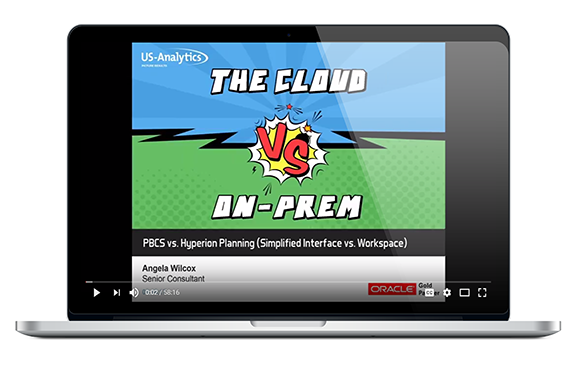The October updates for Oracle's Planning & Budgeting Cloud Service (PBCS) and Enterprise Planning and Budgeting Cloud Service (EPBCS) are here. This blog post outlines several new features for both applications, enhancements, removal of support, and fixed defects.
The monthly update for PBCS and EPBCS will occur on Friday, October 20 during your normal daily maintenance window.
Planning and Budgeting Cloud & Enterprise Planning and Budget Cloud
New EPM Automate Utility Version
A new version of the EPM Automate Utility is available with this update. This version includes updates to the login command, which now accepts internet proxy server domain, user name, and password asoptional parameters. This enhancement enables you to use the EPM Automate utility in corporate network environments with internet proxy server configurations that require users to authenticate with the proxy server before establishing communication with resources outside the corporate network.
New Simplified Audit
Service Administrators can now use the Simplified Audit feature to view data tasks performed by users. Once auditing is enabled for data tasks, you can filter tasks by date range (e.g. Yesterday, Last 60 Days, or Custom, where you specify the start and end dates) and user name. You can also export all of the records that match the filter criteria to a Microsoft Excel file.
To access the Simplified Audit feature, from the Home page, click Application, and then click Audit. To enable data tasks for auditing, click Enable Auditing. To export records to a Microsoft Excel file, click Export.
Enhanced HsGetValue Function
The HsGetValue function now supports the use of attribute dimensions and members with these Oracle EPM Cloud sources:
- Oracle PBCS
- Oracle EPBCS
For information on using the HsGetValue function, see the “HsGetValue” topic in Working with Oracle Smart View for Office.
Display Localized Labels in Referenced Navigation Flow Cards, Tab, and Clusters
When referencing cards, tabs, and clusters from another navigation flow or from another subscription, the system now displays the localized labels that were specified while defining the source navigation flow. To update the card, tab, and cluster labels in your navigation flow, on the Home page, click Tools, and then click Artifact Labels.
Valid Intersections in Dashboard POVs
The POVs in dashboards now honor valid intersections by hiding invalid Page members.
Ability to Set All Dimensions for a Point of View at One Time
In Financial Reporting Web Studio, you can now set all the dimensions for a point of view at one time without having to open and close multiple windows.
Control Line Width in Dashboard Charts
In the dashboard designer, a new Line Weight counter lets you set how thin or thick lines display in Line and Combination chart types:

You can change the default 5 pixel line width to 1 through 12 pixels.
Custom Colors in Dashboards
Your company may use a standard set of colors in charts to denote different types of data. For example, dark blue might represent actual data versus light blue for budget data. When you customize dashboard colors, you select colors in the order of rows on the form. Series 1 represents the first row of data, and so on. You can assign each row in the form a color that represents its data in the chart.
You can customize dashboard colors in Bar, Line, Area, Bubble, Column, Combination, Doughnut, Pie, Radar, and Scatter chart types.

To select a shade of color not initially displayed, click Custom Color.
EPBCS Only
Enhanced Associate Employee Business Rule
When you associate an existing employee with a hiring requisition, the Associate Employee business rule now includes the employee’s compensation expenses in the totals and reduces the compensation for the hiring requisition based on the headcount and FTE of the existing employee. You no longer need to run the Calculate Compensation business rule to calculate the compensation expenses for the hiring requisition and for the existing employee after associating an employee with a hiring requisition.
Data Import Templates Available from Workforce and Capital Business Processes
For the Workforce and Capital business processes in EPBCS, data import templates are now available for download from within the application. The templates are generated based on the features you’ve enabled. From the Configure page for Workforce or Capital, from the Actions menu, select Download Data Load Templates.
New Custom Dimension in Products
In the Projects business process in EPBCS, you can now add an additional custom dimension. This feature is available for new applications. You must add new dimensions when you first enable Projects. When you add a custom dimension, calculations, forms, and other artifacts include the additional dimension.
New Validate Tab to Identify Incorrect Smart List Values
In the Workforce business process of EPBCS, a new Validate tab helps you find incorrect Smart List values (for example, there’s numeric instead of text data). Incorrect Smart List values cause an error when you run predefined business rules.
Groovy Rules Support for Planning ASO Cubes
You can now create business rules written in the Groovy scripting language for Planning aggregate storage cubes.
Removal of Support
Standard Interface (Planning and Budgeting Cloud Workspace Interface)
This change affects PBCS customers who activated their subscriptions on or before July 31, 2016 only.
The Simplified Interface, an option available in the service since November 2014, will be established as the standard across the service. As a result, the current Standard Interface, which is also known as the EPBCS Workspace, will not be supported starting with the December 2017 update to the service (December 1, 2017 for test instances and December 15, 2017 for production instances). After the deployment of the November update to production instances on November 17, 2017, bugs or enhancements for the Standard Interface will not be addressed.
To prepare for this change, watch the webinar replay.
Classic Dimension Editor
For users of the Simplified Interface, effective the February 2018 (18.02) update, the Dimensions link in the Navigator will link to the Simplified Dimension Editor, which was released with the 17.05 update (May 2017). Consequently, the Classic Dimension Editor will not be supported starting with the February 2018 update to the service (February 2, 2018 for test and February 16, 2018 for production instances).
Financial Reporting Studio Desktop Client
Oracle is committed to providing a simple and intuitive user experience. To achieve this, Financial Reporting Web Studio, available since March 2016, will become the only environment for designing and building reports.
Oracle is providing additional time for users to transition from Financial Reporting Desktop Studio to Financial Reporting Web Studio. Tentative plans call for functional parity between Financial Reporting Web Studio and Financial Reporting Desktop Studio in late 2017, at which time, support for the desktop Studio will transition to the Web Studio and distribution of the Desktop Studio will cease.
Oracle recommends that you transition to using Financial Reporting Web Studio at the earliest opportunity. Please send questions and concerns to Oracle using the Provide Feedback option in the service.
Fixed Defects
|
Defect Number |
Description |
|
26802092 |
Batches that include a point of view member that has a ~ character in the member name now render correctly. |
|
26791152 |
Dynamic Time Series reports are now working correctly again. |
|
26784648 |
Access logs now correctly identify the screens that users accessed, user action in the screen, and object value. |
|
26718035 |
Dashboards in the Oracle Cloud My Services portal now correctly display the size of the service instance data in the database. |
|
26669939 |
In the Benefits and Taxes configuration option in the Workforce business process, the Version drop-down list is now selectable in the Filter dialog box, even if Enable for Process Management isn’t enabled for Versions. |
|
26591275 |
When you enable the Capital business process, you can now rename the Account dimension without getting a duplicate alias error message. |
|
26520777 |
Supporting Detail now prevents you from incorrectly trying to add a child to a column. |
|
26517101 |
When an employee’s status is changed from Active to Maternity, the Maternity status is now correctly carried forward to subsequent years for the specified duration. |
|
26393289 |
You no longer receive an error when selecting the members of each dimension in Financial Reporting Web Studio. |
|
25559995 |
The error, Member does not exist for the specified cube, no longer occurs when performing drill-through to Data Management sources. |
Considerations
Microsoft Excel Known Issue that Affects Smart View for Office
Due to an issue with Microsoft Office, using the copy and paste functionality in Excel and then performing any Smart View operation (such as Refresh, Zoom In, or Submit) causes Smart View to stop responding in the following cases (bug number 26796966):
- Copying a column to multiple columns if the column copied contains a Smart List or the database to which you’re connected supports duplicate member names.
- Copying one Smart List cell to multiple cells
- Copying one member cell to multiple cells if the database to which you’re connected supports duplicate member names
- While designing the ad hoc grid and copying and pasting columns or cells, ensure that the Member Name Display option is set to "Distinct Member Name Only." The Member Name Display option is in the Member Options tab of the Options dialog box.
- After pasting, save the workbook and reopen it, then perform the refresh.







